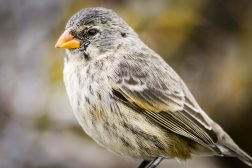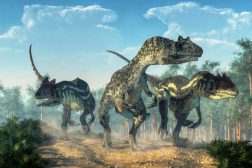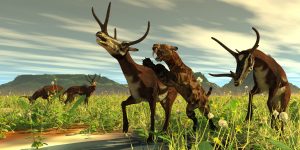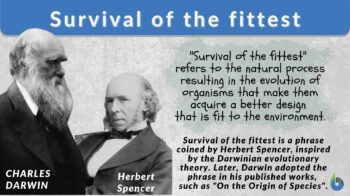
Survival of the fittest
n., [sɚˈvaɪvəl ʌv ðə fɪttɛst]
Definition: The natural process resulting in the evolution of organisms to make them fit to the environment
Table of Contents
When we talk about evolutionary processes, the usage of the phrase “Survival of the fittest” has been very common in evolution and biology. It depends on how well one performs and how “fit” the individual is in the cut-throat competitive world. When asked what the survival of the fittest means in humans, a layman might understand the ordinary usage. But in biology, we need to understand how this phrase came into existence and became so important in the biological world. Read on to learn what survival of the fittest is in biology…
Survival of the Fittest Definition
In biology, the definition of survival of the fittest is this, “a natural process resulting in the evolution of organisms best adapted to the environment”. The origin of this phrase is from the evolutionary theory proposed by Charles Darwin, an English naturalist and evolutionary biologist. He used this phrase to describe how the natural process of selection works and how the existence of different biological organisms is taken care of by the forces of nature.
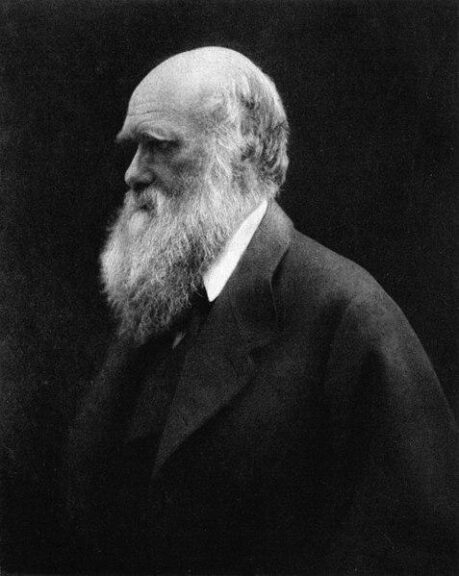
Meaning of fitness from a biological perspective
When we talk about fitness from the biological perspective, it’s not solely the physical fitness that we emphasize, but reproductive fitness and reproductive success serve as crucial deciding factors for overall fitness. When evolutionary biologists use this term, they tend to convey the meaning that a biologically fit organism is expected to leave as many (maximum) progenies as possible. Leaving more progenies ensures that the maximum copies of an organism continue to inhabit the Earth even when that parent individual organism ceases to exist (after its death). Such fitness, in all its totality, takes care of the “species continuation” BUT with “the best gene pool”.
Interpreted as Expressing a Biological Theory
When we are asked to explain natural selection and survival of the fittest in the subject of Biology, we take forward the concept of biological or reproductive fitness. In contrast to the fit individuals or species, unfit individuals or species don’t pass the test of producing enough copies of their own.
Even though we tend to commonly use this phrase up to the individual level, such evolutionary processes usually play out their roles that are ‘observable and significant’ at the species level. And even the effect of this selection of the fittest is reflected at the species level. When we talk in a more scientifically aligned manner, “reproductively fit” means those inheritable characters that empower a species to amp up and boost its chances of producing “the fittest” generation, year after year, decades after decades, era after era, and so on…
To make it further clearer for you to understand, let’s take the example of viruses. The survival of the fittest in the virus world depends on those trans-generationally inheritable attributes that endow a virus with the ability to produce more viruses (higher viral load) with more virulence than the parental generation virus.
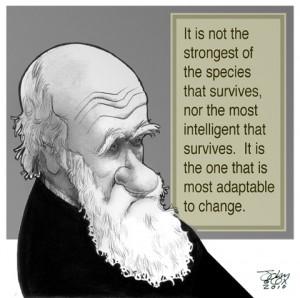
How This ‘Survival of the Fittest’ Phrase Came Into Existence
Charles Darwin drafted and published his writing called “Principles of Biology” in 1864. In this writing, there was one of his now-acclaimed and highly well-received segments by the scientific community on “On the Origin of Species”. It was after reading this writing of Darwin and drawing parallels between Darwin’s biological theory and his own economic theory that a well-renowned philosopher Herbert Spencer introduced the Survival of the fittest. He further strained the connection of biological natural selection introduced by Darwin to his economic theories. And this came into the limelight when Herbert Spencer connected his survival of the fittest to Darwin’s natural selection concept.
It was Alfred R. Wallace who suggested to Charles Darwin to use this phrase introduced by Spencer in the biological world. Then, Charles Darwin adopted the usage of this phrase in place of natural selection. Additionally, he introduced and totally replaced the use of natural selection and published these changes in “The Variation of Animals and Plants Under Domestication” in 1868. Also, in the 5th edition of the “On the Origin of Species” (1869), Charles Darwin introduced the survival of the fittest phrase and explained it as the mechanism of nature to design more efficient, fine-tuned, and better-selected individuals with the optimum gene pool for a specific immediate and local environment.
So, this is how a phrase so commonly used by biologists and laymen came into existence. It traversed paths ranging from the economical schools of thought to the biological arena.
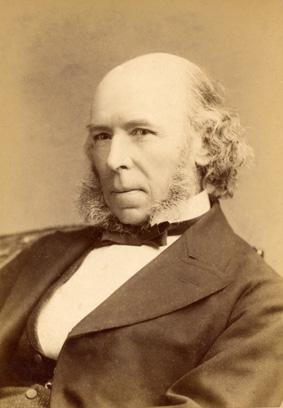
How is ‘Survival of the Fittest’ Phrase Used in Evolutionary Theory
In evolutionary biology, nothing is absolute; everything that is affected by the forces of nature is always relative. Along the same line, Darwin explained all the processes of evolution including ‘the survival of the fittest’ (Darwinism survival of the fittest) as relative and not absolute. He elaborated that the same species that is the best performer and the fittest under a given set of conditions can be lost to extinction under a different set of environmental conditions. If you take a look at the fittest of the species that have gone extinct now, you can come to know that reproductive fitness is also not absolute. It depends heavily on the environmental factors prevailing in a location at a given point in time.
One of the easiest examples (survival of the fittest examples) is the wooly mammoths. Once the fittest (both physically and reproductively) among all the other biological beings on the Earth, the wooly mammoths vanished from the face of the planet Earth some 1000 years after their evolution. This is a clear depiction of nothing being absolute in space and time. Everything, even the fittest population is the topmost only in a defined set of conditions and factors.
Interpreted as Expressing a Moral Theory
This survival of the fittest phrase can be interpreted from a different perspective than the biological sense. When expressed as a moral theory, it is linked to the role this phrase serves and points to in the social dimension of life. Let’s look at it in a point-wise manner.
Social Darwinists
The theory of social Darwinism explains that the different ethnic groups, classes, and races of human beings are influenced and subject to the exact same rules and laws of natural selection that were elaborated by Charles Darwin for other biological beings like plants and animals.
This theory gained popularity in the late 19th and early 20th centuries. This concept enlightens that anthropogenic societies are equivalent to organisms that are under constant haul for competition. This continuous struggle to prove to beat the competition and prosper drives ‘the fittest society’ to the peak of evolution.
The weak society eventually gets diminished in size, number and impact. Not just diminished, the weakest societies witness delimitation and regression of their cultural and traditional dimensions, influences, and representation. The stronger and more competitive societies beat the weaker ones to rise in power leading to overall increased cultural influence in general.
In short, believers and followers of social Darwinism postulated that human lives in an anthropogenic society are always under competition for mere existence. This constant competitive instinct makes one or the other human society the fittest of them all. And this postulate hence justifies the “survival of the fittest” theory in a non-biological sense.
Representatives and propagators of the theory of social Darwinism in England were Herbert Spencer and Walter Bagehot. The representative (and propagator) of the theory of social Darwinism in the United States of America (USA) was William Graham Sumner.
The motto of the theory from a moral perspective is to gain support for capitalism and social and political conservatism. The basis for justification of the motto is the social Darwinists justifying class stratification by saying that these classes are based on natural inequalities among different individuals. They also relate the controlling behavior of the rich class to the inherent superior and moral attributes. Some of these attributes are industriousness and frugality.
How the theory of social Darwinism was propagated? Whenever some attempts were made to reform human societies via government intervention or moral perspective, the social Darwinists would intrude and intervene claiming it to be against the natural processes. They would claim that biological selection is always in favor of unrestricted and cut-throat competition between biological beings. Hence, human societies too, need to be in continuous war with each other in order to acquire and retain powerful positions in society. Under such a selection theory, the poor are always downgraded to the unfit class. Additionally, this theory never even leaves room to aid and help the poor to get uplifted as it justifies the wiping away of the poor due to their less favorable attributes.
Cons of this theory:
- This theory ONLY served as the justification tool for the increasing gaps between poor and rich in anthropogenic societies.
- The class differences and the struggle for mere existence were all justified by the blanket cover of social Darwinism.
Additionally, only “being rich and wealthy” was treated as a sign of success in societies.
This theory of social Darwinism was heavily exploited as a tool for justifying the ever-increasing imperialism, colonialism, and racism in different domains of society.
Anarchists
The way anarchists viewed the phrase survival of the fittest was again different from social Darwinists. There was one Russian anarchist named Peter Kropotkin who explained the concept of survival of the fittest as a supporting tool (cooperation) and not as a competitive tool.
Peter Kropotkin in his book named “Mutual Aid: A Factor of Evolution” pointed out clearly that the fittest in a group might not always be the best. He emphasized the point that even if an individual is the fittest in some competition, the chances of him being the best are not 100%. He explained that a well-functioning community has to be composed of those individually best people who can come together and work their level best as a team.
Eugenics
Eugenics literally stands for eu– meaning good or well and genic meaning “coming into being or growing”. Eugenics is basically a set of beliefs that target to improvise the genetic quality of an anthropogenic population.
Eugenics comes into play when efforts are taken to selectively include and exclude certain groups of people based on their attributes. These attributes are defined on the basis of misaligned notions of wealth, some classes and races being superior to another.
Eugenics also demotes some races and groups of human populations as inferior to others, leaving them with no chances to rise to positions of power and decision-making in politics.
In the 1820–1914 phases, logic about the survival of the fittest and natural selection became popular. It became a common notion that survival of the fittest is applicable to different groups in humanity with the more intelligent people being claimed superior and fitter than the less intelligent ones who were automatically considered less fit and inferior.
It was a British scientist named Francis Galton who first coined the term eugenics meaning the one born with the good genes. He propagated the idea of “over breeding” of the superior, intelligent class. In 1907, this idea was cemented at the Eugenics Education Society of London by Galton. He took forward this idea along with other representatives of the educated class. The aim was to actively and voraciously discourage the heavy over breeding of the relatively less fit class. They aimed at preserving the more intelligent and fitter class of Victorian society.
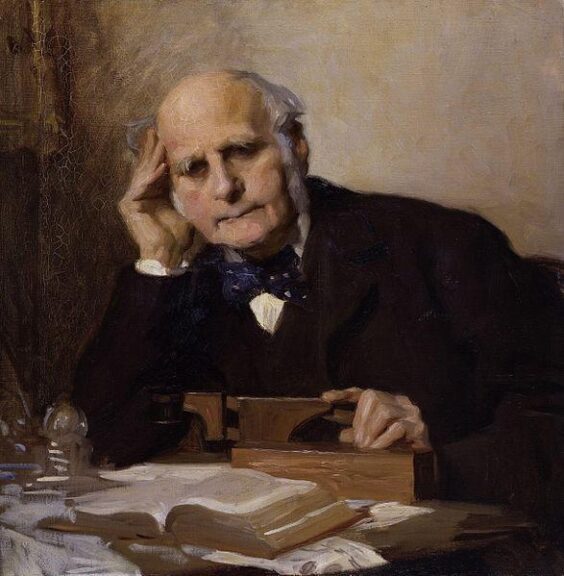
Answer the quiz below to check what you have learned so far about ‘survival of the fittest’.
Further Reading
References
- Spencer, Herbert (1864). Principles of Biology, Volume 1. Williams and Norgate. p. 444.
- Darwin, Charles (1869), On the Origin of Species by Means of Natural Selection, or the Preservation of Favoured Races in the Struggle for Life (5th ed.), London: John Murray, p. 72
- Corey, Michael Anthony (1994), “Chapter 5. Natural Selection”, Back to Darwin: the scientific case for Deistic evolution, Rowman and Littlefield, p. 147, ISBN 978-0-8191-9307-0
- Colby, Chris (1996–1997), Introduction to Evolutionary Biology, TalkOrigins Archive, retrieved 22 February 2009
©BiologyOnline.com. Content provided and moderated by Biology Online Editors.

